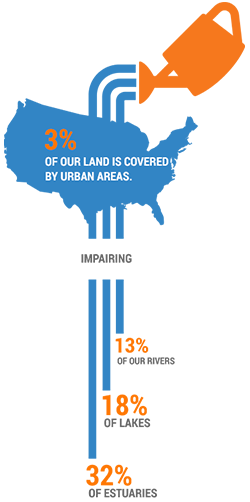Turn Your Yard into a Super Hero
Rainwater is one of our most valuable natural resources. But even with a light rain, roofs, lawns, driveways, sidewalks and streets can shed millions of gallons of water that were once absorbed and filtered by the earth.
This runoff gathers pollutant and speed, finding its way into our creeks, streams and lakes – eroding shorelines and fouling the water.
Here’s where you and your yard can make a difference. Just one rain garden with one inch of rainfall can capture as much as 1,500 gallons of water. Get your friends, family and community involved and see what a difference we could all make towards cleaner water, less erosion, and a healthier ecosystem.

As we grow the ShowMe Rain Gardens community we will be collecting rainfall collection statistics in your area and around the region
Check back here to see the impact rain gardens are having in our region.
Reduce Runoff, Improve Water Quality

Nationally, even though urban areas cover only 3% of our land, they are the primary source of ecosystem impairment for 13% of our rivers, 18% of lakes, and 32 of estuaries. Even in the heart of the Midwest, we negatively impact not only our local waters, but waters as far as the Gulf of Mexico where the Mississippi drains.
A rain garden is a simple but effective step that anyone can take.
Even a small rain garden reduces runoff, which means less pollutants and less water entering our streams. That translates into healthier streams by:
- Filtering pollutants safely and naturally
- Reducing stream bank erosion
- Decreasing rooftop and surface runoff
- Lowering water volume entering storm system
Restore Ecosystems, Increase Biodiversity
Native plants – those that evolved locally – are the super performers in rain gardens. Not only do they thrive with minimal care, they also provide food, shelter and nesting habitat for wildlife such as birds, frogs, and turtles and beneficial insects like butterflies, ladybugs and honey bees.
As an added bonus, a rain garden can enhance property value by creating a beautiful, functional addition to your landscape.

Did You Know?
You share more in common with Missouri’s farmers than just the food on your table. When you put in a rain garden, you join farmers across the state who are also working to care for and conserve our soil and water resources. A rain garden is a scaled-down version of the filter strips farmers use to control runoff from a crop field. You might build a bioswale to direct water to your rain garden. Scale that up and it’s called a diversion, which a farmer builds on a crop field to direct water flow. The native plants in your rain garden create a micro habitat for pollinators and amphibians much the same way a field border creates habit around a farm field.
Learn more about the work of soil and water conservation districts and their programs and how you already support those efforts. Together, our rural and urban communities can do a lot to care for our natural resources.


